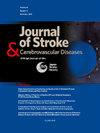Hypoxia inducible factor-1alpha expression correlates with inflammatory injury of blood-brain barrier which influences perihaematomal edema after intracerebral hemorrhage
IF 2
4区 医学
Q3 NEUROSCIENCES
Journal of Stroke & Cerebrovascular Diseases
Pub Date : 2025-03-03
DOI:10.1016/j.jstrokecerebrovasdis.2025.108269
引用次数: 0
Abstract
Backround
In patients with intracerebral hemorrhage (ICH), perihematomal edema (PHE) significantly worsens the prognosis. This condition leads to the formation of a hypoxic microenvironment surrounding the blood-brain barrier (BBB), which in turn activates hypoxia-inducible factor-1 alpha (HIF-1α), a highly sensitive hypoxia-related transcription factor. Additionally, tumor necrosis factor-alpha (TNF-α) emerges as a promising biomarker for tracking inflammation in the vicinity of the BBB. The integrity of the BBB is maintained by proteins such as zonula occludens-1 (ZO-1), which is crucial for the tight junctions that regulate the barrier's permeability. Understanding these mechanisms is vital for developing targeted therapies to mitigate the effects of ICH.
Object
Through the collection and analysis of peripheral blood and tissue samples from ICH patients and animal models at predefined time points, we established the correlation between HIF-1α expression, inflammatory damage to the BBB, and the development of PHE.
Methods
Ethical approval was secured from relevant Chinese authorities and the Ethics Committee of Qinghai Provincial People's Hospital. The clinical study included 32 ICH patients, with computerized tomographic scans and blood samples taken at 1, 3, 7, and 14 days post-ICH. HIF-1α and ZO-1 expression, as well as TNF-α levels, were measured using enzyme-linked immunosorbent assay, quantitative real-time polymerase chain reaction, and western blot. In the animal study, 18 adult Sprague Dawley rats were divided into sham, ICH, and HIF-1α Inhibited groups. Lificiguat YC-1 was used to inhibit HIF-1α expression, and samples were collected at the critical change point identified clinically for similar measurements.
Results
At 3 days after onset, the highest level of HIF-1α and TNF-α, the lowest level of ZO-1 and the most obvious development in PHE appeared in ICH patients (F ≥ 10.278, P ≤ 0.004). At that day, HIF-1α expression positively correlated with TNF-α levels (r = 0.809, P<0.001); TNF-α negatively correlated with ZO-1 expression (r=-0.840, P<0.001) which negatively correlated with PHE development (r=-0.601, p<0.001). Comparing to sham group and sole ICH group, after HIF-1α expression was inhibited, all the biological indicators level of ICH rats were the lowest (F ≥ 14.953, p ≤ 0.005). Their correlation were the same as that in ICH patients.
Conclusion
At 3 days after onset of ICH, HIF-1α expression correlated with inflammatory injury of BBB, which influenced PHE.
缺氧诱导因子-1 α的表达与脑出血后血脑屏障炎症损伤影响血肿周围水肿有关
背景在脑出血(ICH)患者中,血肿周围水肿(PHE)显著恶化预后。这种情况导致血脑屏障(BBB)周围缺氧微环境的形成,进而激活缺氧诱导因子-1α (HIF-1α),这是一种高度敏感的缺氧相关转录因子。此外,肿瘤坏死因子-α (TNF-α)作为追踪血脑屏障附近炎症的有希望的生物标志物出现。血脑屏障的完整性是由诸如封闭带-1 (ZO-1)之类的蛋白质维持的,它对调节屏障通透性的紧密连接至关重要。了解这些机制对于开发靶向治疗以减轻脑出血的影响至关重要。目的通过在预定时间点采集脑出血患者和动物模型的外周血和组织样本进行分析,建立HIF-1α表达、血脑屏障炎症损伤和PHE发展之间的相关性。方法经中国有关部门和青海省人民医院伦理委员会批准。临床研究包括32例脑出血患者,在脑出血后1、3、7和14天进行计算机断层扫描和血样采集。采用酶联免疫吸附法、定量实时聚合酶链反应和western blot检测HIF-1α和ZO-1表达以及TNF-α水平。动物实验将18只成年大鼠分为假手术组、脑出血组和HIF-1α抑制组。Lificiguat YC-1用于抑制HIF-1α的表达,并在临床鉴定的关键变化点收集样品进行类似测量。结果脑出血患者发病后3 d HIF-1α、TNF-α水平最高,ZO-1水平最低,PHE发展最明显(F≥10.278,P≤0.004)。当日HIF-1α表达与TNF-α水平呈正相关(r = 0.809, P<0.001);TNF-α与ZO-1表达呈负相关(r=-0.840, P<0.001),与PHE发展呈负相关(r=-0.601, P<0.001)。与假手术组和单纯脑出血组比较,抑制HIF-1α表达后,脑出血大鼠各项生物学指标水平均最低(F≥14.953,p≤0.005)。其相关性与脑出血患者相同。结论脑出血发病后3 d, HIF-1α表达与血脑屏障炎症损伤相关,影响PHE。
本文章由计算机程序翻译,如有差异,请以英文原文为准。
求助全文
约1分钟内获得全文
求助全文
来源期刊

Journal of Stroke & Cerebrovascular Diseases
Medicine-Surgery
CiteScore
5.00
自引率
4.00%
发文量
583
审稿时长
62 days
期刊介绍:
The Journal of Stroke & Cerebrovascular Diseases publishes original papers on basic and clinical science related to the fields of stroke and cerebrovascular diseases. The Journal also features review articles, controversies, methods and technical notes, selected case reports and other original articles of special nature. Its editorial mission is to focus on prevention and repair of cerebrovascular disease. Clinical papers emphasize medical and surgical aspects of stroke, clinical trials and design, epidemiology, stroke care delivery systems and outcomes, imaging sciences and rehabilitation of stroke. The Journal will be of special interest to specialists involved in caring for patients with cerebrovascular disease, including neurologists, neurosurgeons and cardiologists.
 求助内容:
求助内容: 应助结果提醒方式:
应助结果提醒方式:


